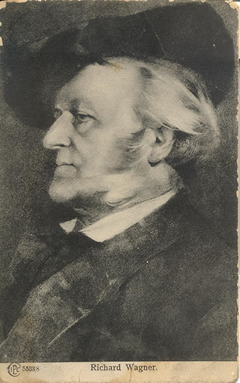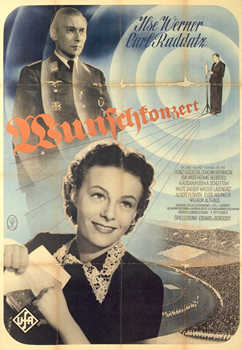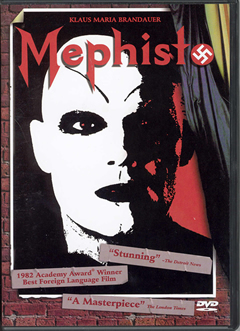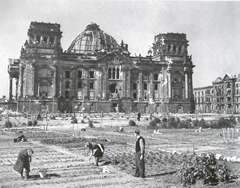1. Introduction: Triumph of the Will (1935)
The opening titles contextualize the film in historical terms (DVD clip):
Triumph des Willens
Das Dokument vom Reichsparteitag 1934
Hergestellt im Auftrage des Führers
Gestaltet von Leni RiefenstahlOn 5 September 1934 [day of the rally]
20 years after the outbreak of the world war [1914]
16 years after the beginning of Germany's suffering [1918-1934! "Stab in the back"]
19 months after the beginning of Germany's rebirth [1933-1934]
Adolf Hitler flew again to Nuremberg to review his faithful followers [charismatic cult of personality, or Führerprinzip, and community of the people, or Volksgemeinschaft]* * *
Documentary or Propaganda? The aesthetization of politics and the politization of the aesthetic. Can art be separated from politics?
Leni Riefenstahl
Leni Riefenstahl, Olympia
2. Hitler, Goebbels, and the Practice of National Socialist Ideology
Adolf Hitler (postcard 1933)
Adolf Hitler, Church Entrance in Vienna (45)
Adolf Hitler, Odeonsplatz with the Feldherrnhalle and Theatiner Church in Munich (46)
The artist-statesman: "Art is a sublime mission demanding fanaticism"
* * *
Joseph Goebbels, Head of the Ministry for Popular Enlightenment and Propaganda and the Reich Culture Chamber (since 22 September 1933)
Gleichschaltung (coordination or synchronization; in reality the elimination or nazification of all social and political institutions—the political parties, state governments, bureaucracies, and trade unions). Carried out in the spring and summer of 1933. In September the central Reich Culture Chamber was formed. It was composed of the Reich Film Chamber, Reich Music Chamber, Reich Theater Chamber, Reich Press Chamber, Reich Writing Chamber, Reich Chamber for Fine Arts, and the Reich Radio Chamber.
* * *
Book Burning (new window): The war on the modern imagination begins!
"Das war ein Vorspiel nur, dort wo man Bücher
verbrennt, verbrennt man auch am Ende Menschen."
(Heinrich Heine, Almansor, 1821. The lines are given to Hassan, a Spanish Muslim, as he witnesses Christians burning the Koran)
Der Stürmer (The Attacker)
* * *
Censorship—institutional examination and prohibition of printed texts. Centralized in Nazi Germany since April 1935. The Reich Writing Chamber then issued its List of Noxious and Unwanted Writings, indexing 3601 single titles and 524 prohibtions of collected works of authors (October 1935). The list was augmented several times over the following years. It was not made public so as to deceive the public and promote self-censorship on the part of publishers and book traders. Dissemination of indexed works was strictly prohibited (but not their private possession).
Censorship or protection?We abhor the "synchronization of culture" in Nazi Germany and the systematic oppression (not only literary) of critical voices but we approve the removal of writings containing hate speech, racial discrimination, and sexual inequality.
1.) How can we distinguish one censorship from the other?
2.) Read the fire oaths that were proclaimed during the book burning of 1933. Taken out of context, many of these "theses" can be found in national advocacies for censorship even today. What makes them problematic ("dangerous") in the Nazi context?
3.) Who is protected by censorship? Who is discriminated against?
4.) Cultural relativism entails that we give every form of writing equal rights of publication and distribution. What are the reasons and advantages of this approach? What is the problem?
5.) Do you think that the German libraries should completely destroy Hitler's writings? (They have been removed from the public shelves but have been preserved and can be looked at with special permission.)
6.) If we allow censorship, who should have authority to decide which writings should be banned and which should not?
7.) Mindful of Heinrich Heine's famous quote ( “Where they have burned books, they will end in burning human beings”), why are books so important that they are compared with human beings? What is the significance of book "burning"? Why do you think book burning is still practiced?
(Source: http://www.sims.berkeley.edu/academics/courses/is142AC/f03/bookburning.htm)
(Judy Blume on censorship: http://www.judyblume.com/censors.html)
* * *
Goebbels prohibits art criticism in 1936
The "New Direction" in approved motifs:
Georg Günther, Rest During the Harvest (61)
Julius Paul Junghanns, Plowing (61)
Albert Janesch, Water Sports, 1936 (64)
3. The Art of Seduction
“All Germany Listens to the Führer”, VE 301, 1936 (72)
Organized spare time: Strength Through Joy (KdF), Beauty of Labor (SdA)
New Holidays: Harvest Day, Mother's Day, Hitler's Birthday
* * *
“Youth Serves the Führer,” 1936 (79)
“You, Too, Belong to the Führer”, 1936 (79)
* * *
Mass Meetings as Gesamtkunstwerk:Hitler Youth with Standards, Nuremberg Party Rally 1938 (86)
Brigade of the Reich Labor Service, Nuremberg Party Rally 1937 (87)
Honoring the Dead of the Putsch, Nuremberg Party Rally 1934
Triumph of the Will, Track 14 (SA and SS Review): Emphasis on form, uniformity, conformity; choreography of geometric blocks
4. The Art Exhibitions 1937-1941
5. Painting
6. Sculpture
7. Architecture
8. Music
9. Film
Functions of film:
—glorifying (Triumph of the Will, Olympia, Kolberg)—defaming (The Eternal Jew, Jud Süss)
—entertaining and escapist (La Habanera, Feuerzangenbowle)
.
10. Mephisto, or the Dilemma of the Artist in the Third Reich
Heinz Rühmann
Gustaf Gründgens as Mephisto
Hermann Göring
Klaus Mann, Mephisto (1936), opening sentence:
"I hear over eight hundred workers in one West German industrial center were recently tried, and condemned--all of them--to long sentences, at the same trial."
DVD clip, Track 15: "The Renewal of German Culture"
Those who left Those who stayed
Literature, Architecture, the Visual Arts ...
... Film Fritz Lang
Elisabeth Bergner
Lilian Harvey
Asta Nielsen
Ernst Deutsch
Curt Goetz
Peter Lorre
Ernst Lubitsch
Alexander Moissi
Max Ophüls
Erich Pommer
Otto Preminger
Robert Siodmak
Conrad Veidt
Billy Wilder
Adolf Wohlbrück
Leni Riefenstahl
Fritz Hippler
Veit Harlan
Luis Trenker
Heinz Rühmann
Johannes Heesters
Luise Ullrich
Viktor de Kowa
Willy Birgel
Brigitte Horney
Heinrich George
Emil Jannings
Theo Lingen
Hans Moser
Popular Music Marlene Dietrich
Friedrich Hollaender
Fritzi MassaryNico Dostal
Paul Link
Franz Lehar
Zarah Leander
Evelyn Künneke
Marika Röck
Hans Albers
Composers and Conductors Paul Hindemith
Arnold Schönberg
Alban Berg
Ernst Krenek
Kurt Weill
Wilhelm Furtwängler
Richard Strauss
Herbert Karajan
Carl Orff
Hans Pfitzner
Werner Egk
Theater Erwin Piscator
Max Reinhardt
Fritz Kortner
Gustaf Gründgens
11. The End
The false dawn of a new art:
no revolution in the arts, Hitler had merely turned back the clocks
no creative impulse, no permitted expression of conflict with life
no development (those with ideas left)
art became self-glorifying, served a purely ideological purpose
dehumanizing in its grandeur; a perversion and abuse of the ethos of art
* * *Discussion: What is art? The functions of art
——————————————————————————
Works Consulted and Further Reading
- Adam, Peter. Art of the Third Reich. New York: Harry N. Abrams, Inc., 1992.
- Barron, Stephanie. Degenerate
Art: The Fate of the Avant-Garde in Nazi Germany.
Los Angeles: Los Angeles County Museum of Art and New York: Harry N. Abrams, Inc., 1991. - Mann, Klaus. Mephisto.
1936. Trans. Robin Smyth. New York: Random House, 1977
(Szabó, István, dir. Mephisto. 1982). - Spielvogel, Jackson L. Hitler and Nazi Germany. A History. Englewood Cliffs, NJ: Prentice Hall, 1988.










